Can stablecoins break Visa’s moat? Are Amazon & Walmart for real?
On June 13, the Wall Street Journal reported that retail giants Walmart and Amazon are exploring the launch of their own stablecoins. Just days later, on June 17, the U.S. Senate passed the 'GENIUS Act' — a landmark bill establishing federal oversight and regulatory clarity for stablecoins, and for the first time authorising private companies to issue digital dollars under a national framework. These developments have raised fresh questions among investors about whether stablecoin-based payment systems could enable merchants to bypass traditional credit card networks, challenging Visa’s core revenue model over the long term. In this article, we examine the potential adoption of stablecoins by retailers and explore whether they represent an existential threat or strategic opportunity for Visa.
We’re fundamental investors who prioritise cash-generative businesses, so we are sceptical of “crypto” in the speculative sense. That said, we do see a clear distinction between volatile digital assets and the potential utility of blockchain-based stablecoins — particularly in the context of reducing transaction costs in retail.
Take Walmart as a case in point: its EBIT margin is roughly 4%, and unlike retailers in Australia (where Woolworths typically passes credit card fees on to the customer), Walmart absorbs an average ~2% fee on card transactions. If Walmart were able to eliminate these fees by shifting to a stablecoin-based payments system, its EBIT could rise from 4% to 6% — a 50% uplift in operating profit.
Viewed through that lens, it’s easy to understand why large retailers are exploring stablecoins not as a crypto investment, but as a strategic response to margin compression and the inefficiencies of established payment rails.
Critically, even if retail giants such as Walmart or Amazon push card spending onto their own stablecoins, the infrastructure that authorises each transaction, nets thousands of daily obligations, manages fraud, and satisfies global KYC/AML rules still has to exist. Running that “interchange-style” overlay is precisely what Visa already does for about 15-20 bps per transaction, and that modest toll is likely to survive even as the broader merchant discount rate compresses. The real losers would be issuing banks that currently capture the 1-3 % interchange spread, not Visa. In the most plausible scenario, retailers reclaim issuer economics while continuing to pay a slim network fee — whether to Visa or a rival — to avoid the cost and regulatory burden of replicating Visa’s compliance-grade plumbing from scratch.
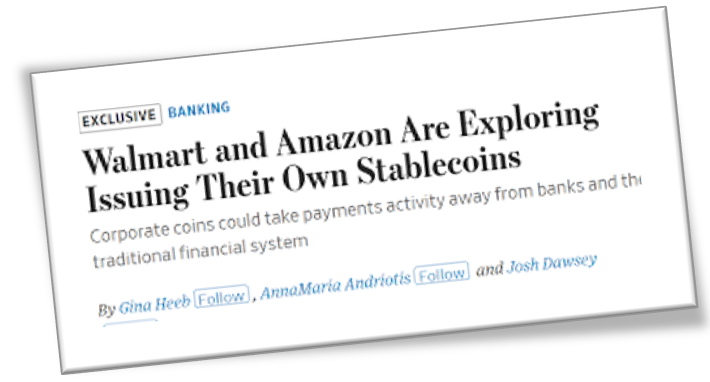
Figure 1: Wall St Journal Article (13th June 2025)
What Are Stablecoins?
Imagine walking into a store and paying with a digital token that’s always worth a dollar. Think of it like using a casino chip or arcade token that’s pegged to real money – that’s essentially what a stablecoin is. Stablecoins are cryptocurrencies designed not to swing wildly in value; they are typically pegged 1:1 to a reserve asset (often the U.S. dollar) to keep their price steady. In plain terms, a stablecoin is a digital dollar (or euro, etc.) that lives on a blockchain. This stability makes them far more practical for everyday transactions than volatile coins like Bitcoin. Just as arcade tokens let you play games without handling cash each time, stablecoins let people transact online or across borders instantly, without the usual banking frictions.
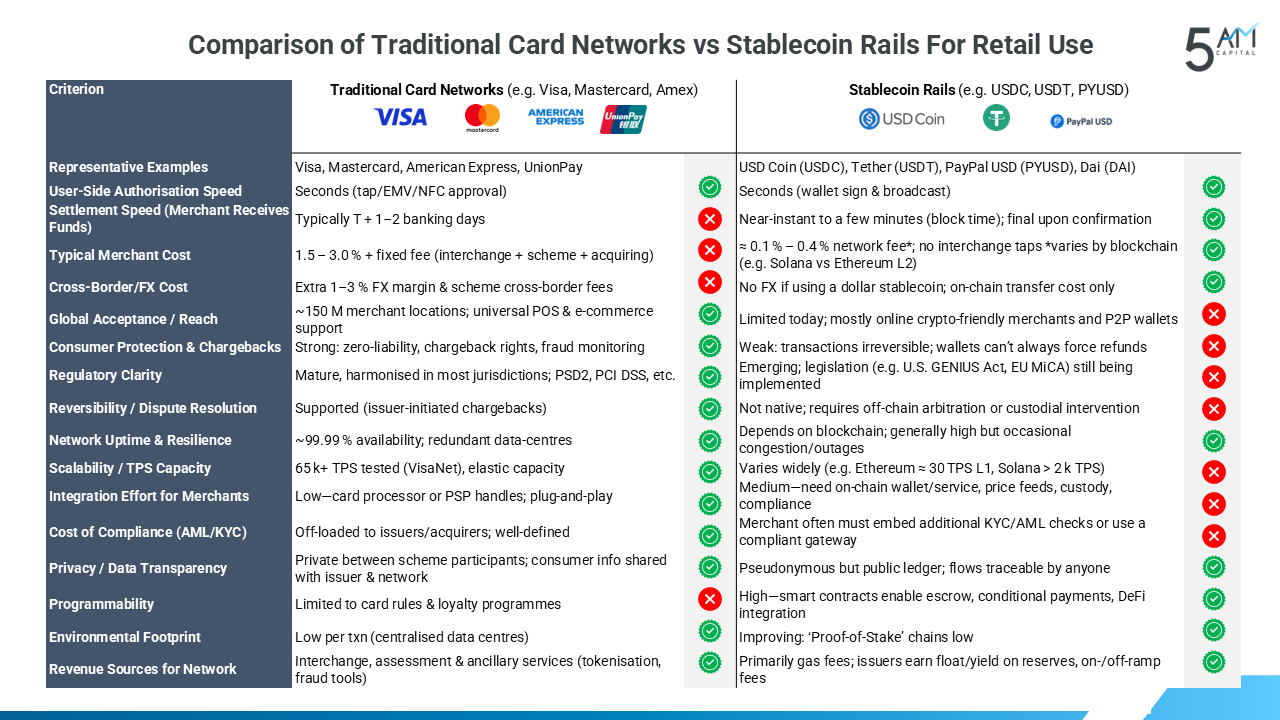
Figure 2: Comparison of Traditional Cards Networks vs Stablecoin Rails For Retail Use Cases (Source: 5AM Capital Analysis)
From Niche to Mainstream: The Stablecoin Surge
Stablecoins have rapidly grown from niche crypto tokens to a major force moving money around the world. Not long ago, stablecoins were mostly used by crypto traders, but their transaction volumes have skyrocketed.
Stablecoin networks handled about $27.6 trillion in transfer volume in 2024, surpassing the combined volume of Visa and Mastercard that year. In other words, these blockchain-based tokens now move roughly twice as much value as Visa does globally. The supply of stablecoins in circulation has been growing ~30% year-over-year, and the total market value of major stablecoins stands around ~$250 billion. This surge reflects how stablecoins are becoming an integral part of digital finance, used for everything from trading and remittances to saving in unstable economies.

Figure 3: Monthly Stablecoin Transaction Volume (US billions) (Source: Visa). USDC and USDT remain the largest stablecoins.
At this stage in the market’s evolution, stablecoins are used mainly as a liquidity rail that lets crypto traders move in and out of positions on both centralized and decentralized exchanges. Consequently, analysts often treat the total stablecoin market capitalization as a rough barometer of overall digital‑asset liquidity: when stablecoin supply expands, order‑book depth and price stability across the crypto complex typically improve. In 2023, stablecoins settled about US$27.6 trillion, with the bulk of that flow tied to trading activity.
For a more conservative reading of on‑chain volume, we apply the filters described in Visa’s April 2024 blog post—published in response to commentary from Nic Carter of Castle Island Ventures. Visa observed that headline figures can be inflated by inorganic behavior such as redundant smart‑contract calls and automated wash traffic. Their adjustment removes repetitive contract‑related transfers and excludes highly active, bot‑driven wallets, counting only those addresses that, within any 30‑day period, initiate fewer than 1,000 stablecoin transactions and move less than US$10 million in total.
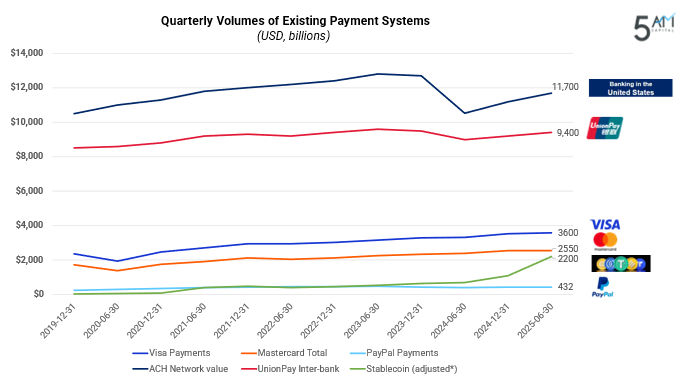
What’s driving this explosive growth? Speed and cost are big factors. Sending money via stablecoin can be faster than bank wires and cheaper than card payments, especially across borders. For example, stablecoins have been touted as a way to bring financial services to over a billion unbanked people worldwide and enable quicker, affordable international payments. Being on blockchain rails means transactions settle in minutes (or seconds), 24/7, without relying on the traditional bank clearing system. Stablecoins essentially bridge the gap between crypto and traditional money, offering digital cash that works globally. This promise has attracted not only crypto enthusiasts but also mainstream institutions – including fintech firms and even banks – to explore stablecoin use. In 2023 and 2024, companies like PayPal (with its PYUSD stablecoin) and fintechs like Stripe began launching or planning their own stablecoins or stablecoin support. Even some major banks have hinted at joining the fray, recognizing that digital dollars could be the next evolution in money movement.
China offers a compelling preview of what bypassing the global card networks can look like. In less than a decade, Tencent’s WeChat Pay (together with Alibaba’s Alipay) built a fully closed‑loop mobile‑payments ecosystem that reaches more than a billion users and processes trillions of dollars a year—without ever touching a Visa or Mastercard rail.[1] Because the wallet, merchant acquiring, and settlement all occur inside the same super‑app, Chinese merchants pay fees closer to 0.4%, a fraction of western interchange. This “leapfrog” shows that when a low‑cost, seamless alternative emerges at national scale, consumers and merchants are willing to skip cards entirely—an instructive analogue as U.S. retailers explore stablecoin rails.
Retail Giants Eye Stablecoins to Bypass Visa’s Toll
If there’s any doubt stablecoins have entered the mainstream conversation, look at Amazon and Walmart. These retail titans each pay billions in fees to credit card networks every year – effectively a toll to Visa, Mastercard and banks for every customer swipe. According to recent reports, both Amazon and Walmart have explored issuing their own stablecoins as a new payment option. The idea is simple but radical: if customers paid using a Walmart Coin or Amazon Coin (pegged to the dollar), the retailer could run its own payment system and sidestep the traditional card networks entirely. Interchange fees (the cut that Visa/Mastercard and banks take on each transaction) could be largely avoided, potentially saving these companies a fortune in the long run. For low-margin retailers, cutting out a 1-3% card fee is huge – imagine recouping that on millions of daily transactions.
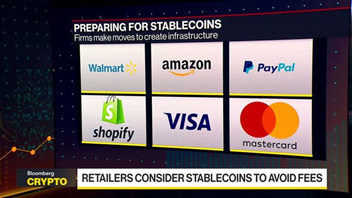
Figure 5: Bloomberg Crypto Feature (2025)
For US megaretailers such as Walmart and Amazon, the incentive to migrate to stablecoins is especially acute because they— not consumers — absorb the card toll. Unlike many other countries where interchange is embedded in shelf prices or surcharged at checkout, the United States requires large merchants to eat roughly 1.4%– 2.2% of every Visa/Mastercard sale on credit.[2] That burden runs to billions of dollars a year for the two biggest retailers. If even a portion of their‑checkout volume shifted to a self‑issued or widely accepted dollar‑stablecoin that settles for cents on‑chain, the annual savings could immediately flow to the bottom line — or be redeployed into lower prices and faster delivery, reinforcing their competitive moat. Additionally, the merchants will need to offer some form of rewards program to incentivise their customers.
The implications of this move are far-reaching. If Amazon launched a stablecoin or started accepting popular stablecoins at checkout, it could keep transactions “in-house” and reduce reliance on banks or Visa’s network. The same goes for Walmart: a customer could top up a wallet with Walmart’s digital dollars and spend them in-store or online with no bank in the loop. It’s essentially a closed-loop payment ecosystem. This prospect has rattled the payments industry. When the news of these explorations came out, Visa’s stock dipped as investors digested the potential threat. After all, if the world’s largest retailers find a way to funnel payments through their own digital coins, they collectively have the scale to chip away at Visa’s payment volume. And it’s not just Amazon and Walmart – the Wall Street Journal noted that other big firms like Expedia and some airlines have also considered corporate stablecoins in the U.S. Merchants are clearly eager to push back against card fees, and stablecoins present a tantalizing tool to do so.
Of course, launching a retailer stablecoin isn’t as simple as snapping fingers. There are regulatory hurdles – in the U.S., new legislation (the “Genius” Act) is being debated to set ground rules for private companies issuing stablecoins. But the momentum is there. Lawmakers are recognizing that if they allow well-regulated stablecoins, it could spur innovation and even strengthen the dollar’s role in the digital economy. In fact, the Senate’s interest in a stablecoin framework underscores that corporate stablecoins are no longer a fringe idea; they’re part of a broader race to shape the future of money. For Visa and Mastercard, this trend is a clear signal that their longstanding grip on payments – via plastic cards and bank intermediaries – may face new kinds of competition.
Do Stablecoins Threaten Visa’s Global Moat?
All this leads to a pressing question: do stablecoins pose a serious threat to Visa’s business model worldwide? The intuitive case is yes – if people and businesses can transact directly using digital dollars on open networks, they might not need Visa’s proprietary network. Already, we see stablecoins gaining traction in use cases like cross-border transfers and remittances (where they can leapfrog slow bank wires). In emerging markets with volatile local currencies, many individuals prefer holding stablecoins (like USDT or USDC) as an alternative to cash, and they can pay each other with mobile apps that use stablecoins. Over time, this could nibble at the edges of card usage, especially for online commerce and peer-to-peer payments.
However, it’s important to separate long-term potential from current reality. Today, stablecoins are still far from replacing credit cards at the checkout line. A recent Federal Reserve Bank analysis noted that while the upside is there, merchant adoption of stablecoins remains low, thanks to several hurdles. These include regulatory uncertainty (many businesses are unsure what rules would apply), concerns about fraud and the lack of chargeback/reversal mechanisms, technical integration challenges, and plain old inertia – both merchants and consumers are used to swipe/tap payments and may not be clamoring for a new method if it’s more complex. There’s also the matter of trust and user experience: Visa and Mastercard offer fraud protection, dispute resolution, and nearly universal acceptance – benefits that open blockchain payments don’t match yet. For the average consumer, pulling out a Visa card or phone wallet linked to Visa is simply easier and more familiar than managing a crypto wallet. As one analysis bluntly put it, consumer habits are sticky; crypto might excite techies, but most people still rely on Visa’s network for its convenience and reliability.
From a global perspective, Visa’s moat is its vast network: over 150 million merchant locations, relationships with thousands of banks, and decades of brand trust. Stablecoins on their own don’t have a network of that scale or the seamless integration into retail systems. A stablecoin transaction typically requires both parties to have a compatible wallet or app, and possibly for the payer to acquire stablecoins first (often via an exchange or bank transfer). That’s additional friction. So in the near term, stablecoins are more of a complement than an outright competitor in many markets – they’re being used for specific niches (like B2B settlements, crypto trading, or remittance corridors) rather than displacing everyday card swipes at the grocery store. This moat is reflected in the high PE multiples that investors are willing to pay for the card rails duopoly (see below), with Visa at 28x Fwd and Mastercard at 32x Fwd), even following the share price pullback.
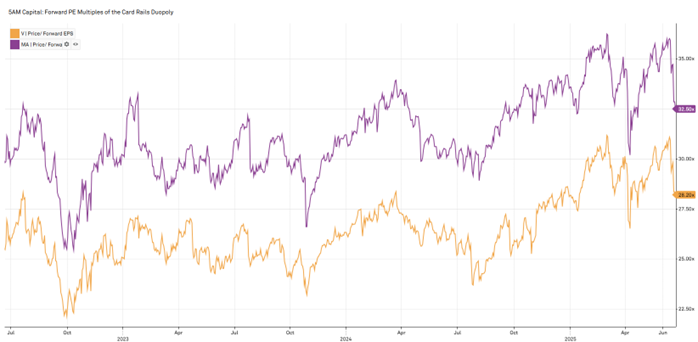
Figure 6: Forward PE of Visa (Orange) and Mastercard (Purple) over the Past 3 years (Source: S&P Capital IQ Pro, 22nd June 2025)
That said, the threat to Visa is credible in the long run if stablecoins continue their growth trajectory. Some in the industry even suggest that as digital assets gain wider acceptance, stablecoin adoption could eventually rival credit or debit cards for payments. We’re not there yet, but the mere possibility means Visa cannot afford complacency. Notably, regulators could be a wild card: if governments globally enact clear frameworks that legitimize stablecoins (and perhaps even issue their own central bank digital currencies), it could accelerate mainstream usage. Conversely, if they clamp down or impose strict backing requirements (like the U.S. proposal to back stablecoins 100% with government bonds), that might slow stablecoins’ rise or keep them largely within institutional channels. In any event, the competitive pressure is likely to increase over time – even if stablecoins don’t dethrone Visa, they might force lower fees or new innovations as merchants gain more leverage to route around pricey established systems.
Visa’s Countermove: If You Can’t Beat ’Em, Join ’Em
Visa is not blind to these trends. Rather than dismissing stablecoins, Visa has been actively experimenting with them – essentially hedging against disruption by embracing the tech. In 2023, Visa made headlines by becoming one of the first big payment networks to pilot settlement in a stablecoin (USDC). Typically, when you use a Visa card, your bank and the merchant’s bank settle the transaction via Visa’s network in a batch, usually using traditional bank wires at day’s end. Visa’s pilot showed that a merchant acquirer could instead settle up with Visa using USDC on the Ethereum blockchain – potentially achieving near-instant, 24/7 settlement instead of waiting for the next business day. According to Visa’s crypto chief, they have integrated stablecoin settlement into their treasury systems and so far processed over $225 million in stablecoin settlements through these trials. It’s a small sum next to Visa’s trillions in volume, but it proves a point: Visa is figuring out how to plug stablecoins into its existing network.
Beyond the back-end plumbing, Visa is also enabling consumer-facing crypto use. The company reports that through various crypto-linked Visa cards (often issued in partnership with exchanges and fintechs), users have made nearly $25 billion in cryptocurrency spending and over $100 billion in crypto purchases (loading crypto via Visa) to date. Many of these cards work by instantly converting your crypto or stablecoins to fiat at the moment of purchase, riding on Visa’s rails. In other words, Visa still gets a slice of the transaction, even if the user is effectively spending stablecoins. And more programs are launching: Visa has been rolling out stablecoin-linked cards with partners like fintech startup Bridge and others to let people spend their USDC or USDT at any Visa merchant. Each of these initiatives signals Visa’s strategy: make sure that if stablecoins are being used, Visa’s network is involved in some way – whether for settlement, conversion, or as the card that interfaces between crypto wallets and merchants.
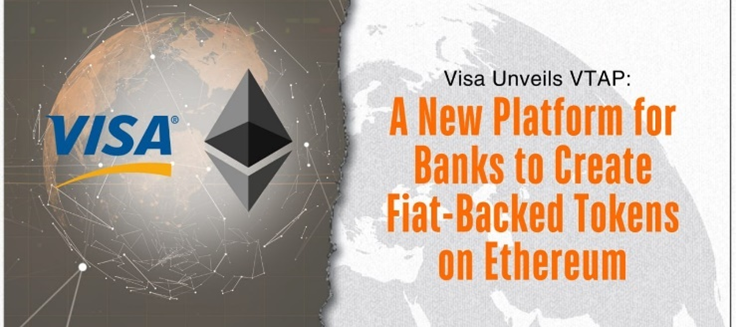
Figure 7: Visa’s Tokenized Asset Platform (Source: Museigen.IO)
Importantly, Visa’s leadership doesn’t see stablecoins as pure threat; they publicly recognize opportunity. As Visa’s Chief Product Officer put it in April 2025, “stablecoins, paired with Visa’s world-class tech, offer the promise to modernize global money movement”. The company launched a program called the Visa Tokenized Asset Platform to help banks and fintechs mint and manage stablecoins (essentially a “blockchain-as-a-service” for digital money). The vision is that Visa can be the go-to infrastructure provider for stablecoin-based services just as it is for card-based services. If banks want to offer customers a stablecoin wallet or if a fintech wants to build a new lending product using stablecoins, Visa aspires to be the enabling network behind the scenes. In short, Visa is playing both defense and offense: defending its turf by integrating stablecoins into its own network (so clients have less reason to leave), and going on the offense by using its scale and trust to offer something new in the stablecoin era.
Competitors and Allies: Mastercard, PayPal, and Circle
Visa isn’t alone in this adaptation. Mastercard, Visa’s closest rival, has been arguably just as aggressive in crypto partnerships. In 2023 and 2024, Mastercard announced deals with crypto firms (like exchange OKX and payments processor Nuvei) to enable stablecoin spending for consumers and even allow merchants to receive payments in stablecoins if they choose. Mastercard’s Chief Product Officer stated that to unlock crypto’s potential, “we need to make it as easy for merchants to receive stablecoin payments as it is for consumers to use them”. They’re working on that 360-degree approach – from issuing cards that spend USDC, to settlement options and on-chain transfer services. In fact, Mastercard recently rolled out stablecoin settlement for certain partners, similar to Visa’s pilot, giving merchants the option to settle in crypto instead of the usual bank route. The message is clear: both major card networks plan to ride the stablecoin wave, not be drowned by it.
Meanwhile, fintech players are leaping in, sometimes in competition and sometimes in collaboration with the card networks. PayPal’s launch of its own U.S. dollar stablecoin (PYUSD) in 2023 was a landmark – here was a traditional payments giant creating a crypto token of its own. With PYUSD, PayPal can let users move money within its ecosystem (and potentially beyond) without touching card networks at all. PayPal’s bet is that a trusted, regulated stablecoin can enhance its platform’s utility (for e-commerce, transfers, maybe interest-bearing features) while keeping users inside PayPal rather than cashing out to bank cards. Stripe, another big name in online payments, has also embraced stablecoins for payouts: it now offers stablecoin payment options to businesses in 100+ countries. For example, a gig worker or creator can opt to receive their earnings in stablecoin to a crypto wallet, which could be faster or more convenient than a bank transfer in some regions. These moves by PayPal and Stripe show that fintechs see stablecoins as a way to expand globally and bypass some of the old pipes (e.g. SWIFT or correspondent banking) – a space Visa and Mastercard also eye for growth.

Figure 8: As of the 22nd of June 2025, Circle is up >600% to a market cap of >US$50 billion following its recent IPO
And then there are the crypto-native companies like Circle, the issuer of USD Coin (USDC). Circle has actively sought partnerships with the Visas and Mastercards of the world, aiming to make USDC as easy to spend as any other currency. USDC is already integrated in various card programs and fintech apps, and Circle’s goal is to become an infrastructure layer for digital money. In a sense, Circle and Visa have a symbiotic relationship – Circle provides the stablecoin liquidity and tech, while Visa provides the acceptance network and user reach. We saw a hint of this synergy when Visa’s pilot used USDC on Ethereum; Circle was effectively powering the funds, and Visa the network. Likewise, Mastercard has partnered with Paxos (issuer of another stablecoin, USDP) for some of its crypto card programs, indicating that the card networks are teaming up with stablecoin issuers rather than fighting them. Even traditional banks are cautiously joining: reports surfaced of big banks discussing a jointly issued stablecoin for interbank uses, which suggests banks might collectively attempt to create their own alternative rails (possibly to preempt losing out to crypto networks). All these developments underscore that the competitive lines are blurring – yesterday’s competitors might be tomorrow’s partners in the quest to modernize payments with stablecoins.
Long-Term Outlook: Disruption or Coexistence?
So, will stablecoins eat Visa’s lunch, or will Visa deftly incorporate stablecoins into its banquet? The most likely scenario is somewhere in between a total disruption and a trivial impact. Stablecoins do represent a genuine innovation in how value can move – instant, low-cost, borderless – and that challenges the established payment model that takes a cut and time at each step. If retailers, fintechs, and even governments push adoption, stablecoins could pressure incumbent networks to lower fees and improve efficiency (for example, enabling 24/7 real-time settlements, something a blockchain does by default). In that sense, stablecoins are a credible catalyst for change in the payments industry globally.
However, Visa’s position has been built over decades and comes with advantages that are not easily replicated by a piece of code. The trust, legal frameworks, anti-fraud systems, and sheer ubiquity of Visa/Mastercard are profound moats. Even as stablecoin volumes exploded, remember that a huge chunk of that $27+ trillion is crypto trading and transfers, not coffee purchases. Many stablecoin transactions are essentially fintech infrastructure (e.g., moving funds between exchanges or arbitraging) rather than consumer commerce. Visa’s bread-and-butter – everyday consumer and business spending – is stickier. It will likely take years for habits and merchant infrastructure to evolve if blockchain payments are to significantly displace card networks. One analyst from Barclays went so far as to call the stablecoin threat to Visa and Mastercard “overblown” in the near term, noting that regulatory uncertainty and consumer inertia give the incumbents time to adapt. Indeed, Visa’s own strategy seems to bank on that: by the time stablecoins are truly mainstream, Visa intends to be a major player in that arena as well, not a casualty.
For investors like 5AM Capital, what’s crucial is that Visa (and its rivals) are not resting on laurels. They’re treating stablecoins both as a potential threat and an opportunity. We see Visa and Mastercard lobbying for sensible regulation (they want a level playing field where they can compete in stablecoin services) and investing in pilot programs to learn the ropes. We also see them highlighting parts of their business less vulnerable to disintermediation – for instance, Visa’s fastest-growing segment is now value-added services (fraud prevention, analytics, etc.), which don’t depend on whether the payment was in dollars or USDC. In other words, Visa is fortifying itself by diversifying revenue streams and ensuring it can “win” no matter which way the payments landscape evolves. As Visa’s CEO recently implied, they view stablecoins as just another way to pay – if people want it, Visa will facilitate it, rather than ceding that business to others.
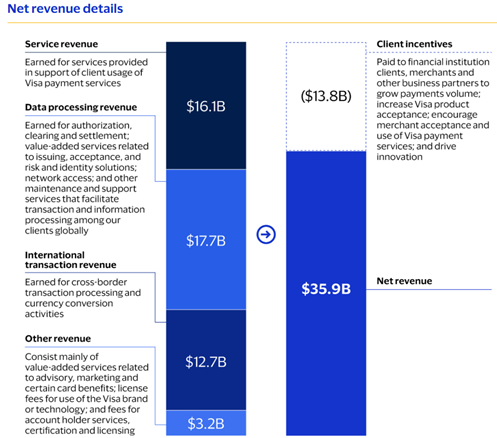
Figure 9: Visa’s FY2024 Net Revenue Breakdown (Source: Visa Investor Relations)
Stablecoins have rapidly gone from curiosity to contender in the world of payments. They could one day rewrite the rules of how money moves, and in doing so, pose a challenge to traditional networks like Visa. Major retailers issuing their own coins to cut out Visa’s fees is no longer science fiction – it’s being explored now. Yet, in the unfolding story of Visa versus stablecoins, it’s not a zero-sum game. Visa is adapting, possibly even benefiting from the stablecoin boom by integrating it (capturing new volumes, offering new services) instead of fighting it. For the foreseeable future, Visa’s dominance won’t likely be toppled overnight by a tech trend – but it will be tested. And that very test is pushing Visa into what could be a new era of innovation for the 65-year-old company. In the end, stablecoins might not kill networks like Visa; they might transform them – forcing these payment giants to become faster, more open, and more versatile in a digital, tokenized economy. That’s a scenario where consumers and businesses win, and where Visa can continue to thrive by steering into the disruption rather than getting run over by it.
Sources:
- World Economic Forum – “Stablecoin surge: reserve-backed cryptocurrencies on the rise” (Mar 2025)
- Investopedia – “Why Walmart and Amazon Are Considering Their Own Stablecoins” (June 2025)
- Cointelegraph/Artemis – “Stablecoin payment volume reaches $94B, driven by B2B transfers” (May 2025)
- Visa Perspectives – “Visa’s role in stablecoins” by J. Forestell (Apr 2025)
- PYMNTS – “Mastercard Partners With OKX and Nuvei to Power Stablecoin Transactions” (Apr 2025)
- AInvest (analysis) – “Visa’s Defensive Play: Why the Stablecoin Threat is Overblown” (June 2025)
5AM Capital
[1] Based on 2024 transaction‑volume disclosures from Tencent and Alibaba.
[2] Nilson Report, “U.S. Merchant Card Fees 2024”; Federal Reserve Regulation II data.
5 topics
5 stocks mentioned

